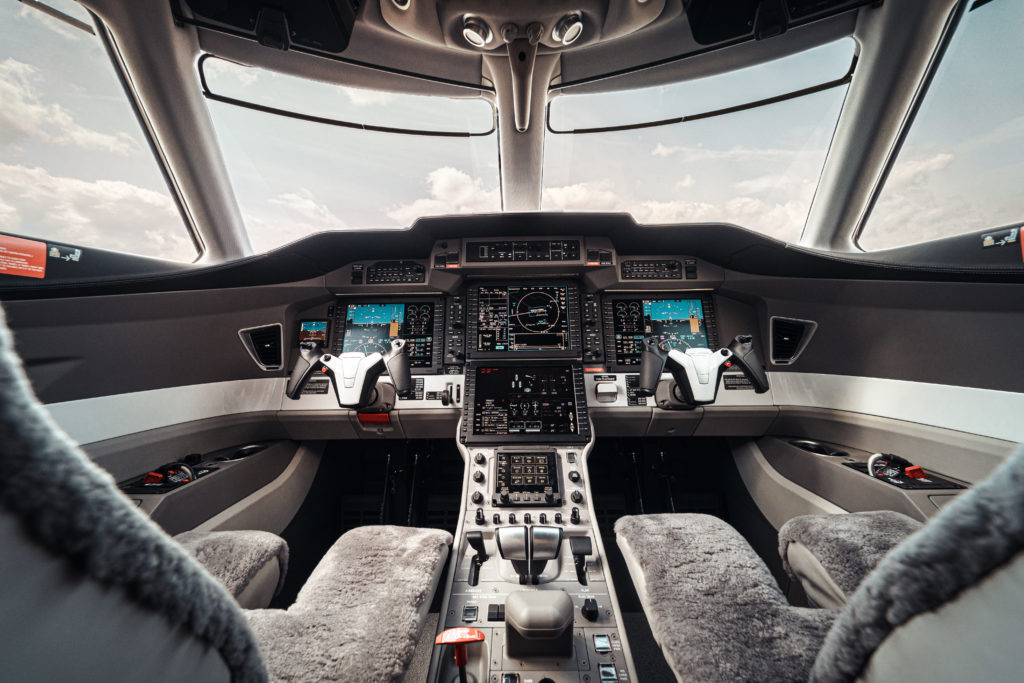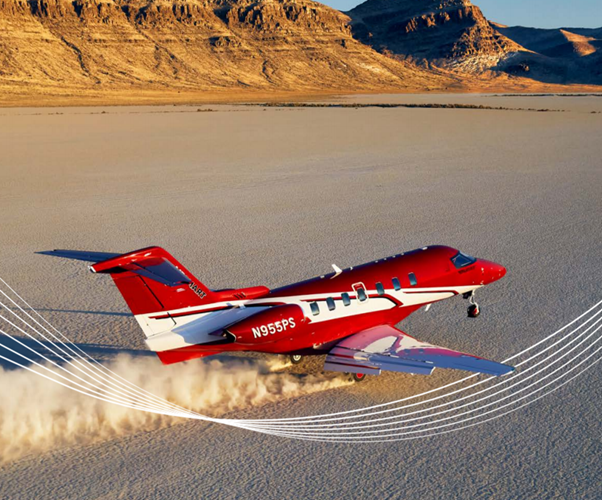
“It’s like a PC-12 but flies a lot faster.” The words belong to Edwin Brenninkmeyer, CEO and founder of Oriens Aviation, the British Isles exclusive distributor for Pilatus Aircraft. We are sitting in the Business Aviation Centre at Farnborough Airport. Outside on the apron (ramp) stands the smart PC-24 jet that Oriens is displaying to prospective customers. Brenninkmeyer believes the aircraft is well-placed to thrive, as private aviation emerges from the cloud of Covid-19.
Pilatus’s first jet, the PC-24, is equally suited to cater for business owners, corporate organisations, or special mission operators, according to Oriens Aviation. “It has strong special-mission capabilities. From an air ambulance requirement to anyone who refuses to travel light with the large cargo door and internal baggage area, alongside the ability to serve remote areas via short, unpaved, and unimproved runways and strips,” he said.
Brenninkmeyer traces the launch of the PC-24 to the success of its elder sister, the PC-12 turboprop. “The success of the PC-12 – characterised by its ability to land in short fields, large cargo door and big spacious cabin – created a niche in the market in terms of versatility,” he said.
“The feedback from the market was that owners loved the PC-12 – they just wanted it to go faster. That’s what led to the development and launch of the super versatile PC-24 jet.”
Go faster it certainly does. The PC-24 has a maximum cruise speed of 440 ktas (815 km/hr) compared with her older sister’s more modest 290 ktas (537.08 km/hr) for the PC-12 NGX. The jet also has longer legs, with a maximum range of 2,000 nm (3,704 km) at long range cruise power and 4 passengers compared with 1,803 nm (3,339 km) for the PC-12.
The PC-24 was certified both in the US and Europe in 2017, with first deliveries beginning in 2018. There are just over 40 PC-24s operating in Europe, according to Oriens Aviation sales director Sacha Demelo.
Scale up or scale down
The twin jet is equally suitable for business aircraft owners who want to scale up or scale down their usage, he says. “We find a lot of interest from PC-12 owners who want to scale up to fly to further destinations – such as southern Spain or Italy – more quickly. Equally, we find people who are downsizing from larger jets,” says Demelo.
“Some owners realise that downsizing to a PC-24 from a bigger business jet is not that much of a downsize but offers significantly lower operating costs.”
Brenninkmeyer takes up the theme: “The operating costs are comparable to a light jet but the cabin is comparable to almost a mid-size jet. Plus, you have all the versatility of a turboprop with the ability to land on short, unimproved runways.”
This will prove a telling advantage in the post Covid-19 world, they believe. The PC-24’s landing distance over a 50ft obstacle is 2,375 ft (724 m), which opens up a range of smaller scale airports. This comes at a time when commercial airlines are struggling to rebuild airline schedules – particularly regional airline schedules – after the carnage of Covid-19.
Evidence to back the claim is supplied by Pilatus. There are around 10,650 airports worldwide that offer access to aircraft able to operate on runways of 3,130 ft (954 m), it claimed. There are an additional 880 airports that become available when your aircraft needs only 2,930 feet (893 m). Both runway categories have to be paved.
“Now, let’s look at the number of runways around the world that offer a length of at least 2,930 ft (893 m) but feature unpaved surfaces – like grass or gravel,” according to Pilatus’s website. “The number is almost 20,000. So, with the PC-24, you will have access to almost 100% more airports around the world. That means you can fly closer to your final destination than with any other business jet.”
Demelo believes business users will find this a compelling proposition. “Businesses want to avoid putting their senior management team on commercial aircraft but still need to fly from site to site within Europe, often using smaller runways than are available in the US.” To date, typical users in Europe are successful entrepreneurs rather than corporates – although companies like Volkswagen choose to operate a fleet of PC-24s.
Brenninkmeyer believes the twin jet will appeal to the new owners who have moved into business aviation for the first time, as a direct result of Covid-19. “The PC-24 is a new product, which is why we are demonstrating the aircraft to people so they can touch it, feel it, and understand what it is all about.”
The PC-24 base price is $10.82m for a 2022 delivery. The price of typically equipped models is about $11.7m. Corporate Jet Investor visited the PC-24 at Farnborough Airport in June.
PC-24 on video tour
Earlier this month Pilatus launched a three-part video tour series of the PC-24 twin jet in order to beat Covid-19 travel restrictions. The first videos feature the OEM’s test pilot Matthew ‘Fish’ Hartkop explaining the features and benefits of the jet’s design, systems, cockpit layout, flying qualities and performance. In the final video, to be released tomorrow (August 13th), Pilatus project manager Marta Esquer Cerezo highlights the aircraft’s comfort and size, flat floor, cargo area, and seating layout and forward lavatory.
Pilatus worked with Honeywell to design the Advanced Cockpit Environment. The design, featuring 12-inch screens, is intended to reduce pilot workload, improving operational safety, and allows the PC-24 to be single-pilot certified. A new automatic yaw trim function is said to further cut flight crew workload during departure and climb phases.
Pilatus’s new CEO Markus Bucher said: “Interest in seeing the PC-24 first-hand has been tremendous and we wish we could host everyone personally here at the factory in Switzerland. Until we get that opportunity, this video tour is the next best alternative.”
PC-24 – at a glance
– Max range: 2,106 nm (3,900 km) at long range cruise power
– Max cruise speed: 440 KTAS (815 km/hr)
– Two Williams International FJ44-4A-QPM engines
– Each provide 3,420 lbf of continuous thrust
– Cabin: 501 ft3 (14.20m3) with flat floor
– Seats up to 11 passengers and one pilot
– Baggage compartment: 90ft3 (2.5m3) internal and pressurised
– Certified for single pilot operations
– Base price: $10.82m.

Top: Oriens Aviation pilot Paul Mulcahy, director of flight operations, who flew the PC-24 into
Farnborough Airport. “The aircraft has the handling feel of a big jet but the agility of a little jet.”
Above: Pilatus worked with Honeywell to design the Advanced Cockpit Environment. The design,
featuring 12-inch screens, is intended to reduce pilot workload, improving operational safety.
Bottom: Tough in the rough. The PC-24 was accorded has full rough field certification last year.


